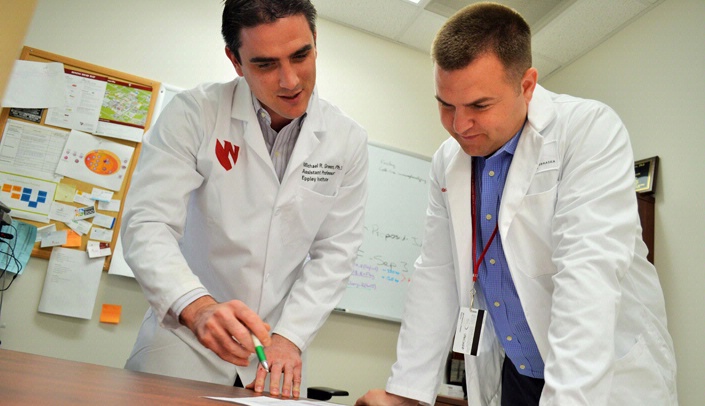UNMC is seeking 24 patients to enroll in a Phase 2a study to evaluate the safety and efficacy of two oral cancer drugs for patients with diffuse large B-cell lymphoma who have relapsed or are resistant to other traditional therapies. Diffuse large B-cell lymphoma (DLBCL) is the most common non-Hodgkin lymphoma.
The study is being headed by a clinician, Matthew Lunning, D.O., and a translational scientist, Michael Green, Ph.D.
“Most cancer treatments come in the form of chemotherapy given intravenously,” Dr. Lunning said. “This is unique because it uses a combination of two oral medications.”
With the Fred & Pamela Buffett Cancer Center at UNMC/Nebraska Medicine scheduled to open in May 2017, Dr. Green said this study is a perfect example of how the cancer center hopes to bring clinicians and scientists closer together.
Dr. Green is assistant professor and coordinator for lymphoma research in the Eppley Institute. Dr. Lunning is assistant professor, UNMC Department of Internal Medicine-Hematology and Oncology. Both have worked collaboratively in the Lymphoma Precision Medicine Laboratory to develop innovative correlative studies embedded within rationally-designed therapeutic studies as part of the James O. Armitage Center for Hematologic Malignancies Research.
Both Drs. Green and Lunning are among the more than 40 new recruits who have been hired since construction of the new cancer center began more than three years ago.
Each of the seven research floors of the Fred & Pamela Buffett Cancer Center will feature a Research and Discovery Suite, an area in which clinicians and scientists working on the same type of cancer will be housed on the same floor. This will allow them to routinely come together and share their ideas to ultimately give patients access to the most cutting-edge cancer treatments.
The study will combine an experimental drug known as TGR-1202 with ibrutinib, an FDA-approved drug. The drugs are designed to target the cancerous B-cell receptor pathway at different points.
“We’re excited to use this two-drug oral therapy,” Dr. Lunning said. “DLBCL patients who relapse following a transplant or are unresponsive to frontline drug therapies remain an unmet medical need and new drug therapies are desperately needed for these individuals.”
“This is a good example of bench to bedside and back again,” Dr. Green said. “Ibrutinib was already in the clinic, but with mixed results. So we spent time trying to understand why it was less effective in some instances, performed experiments to show that a second drug (TGR-1202) could target the escape mechanism, and hopefully we will see better clinical efficacy as a result of the combination.”
